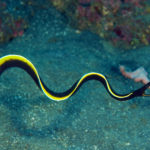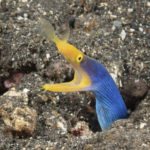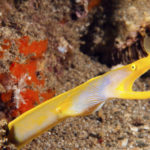It's somehow gratifying when the Latin name for an underwater creature fits so well. The rhinomuraena quaesita, or ribbon eel, owns such a name. And the waters around Wakatobi Dive Resort are the perfect place to spot these elegant creatures.
The ribbon eel
Let's start with its looks. Like other morays (genus muraena), the ribbon eel breathes by opening and closing its mouth, forcing water over its gills. Its yellow, elongated nostrils serve as antennae, allowing it to sense small changes in its environment, such as passing prey. Taken together, these physical traits make the ribbon eel look like it's perpetually sneezing a thick spray of mucus from its nose. The ribbon eel's diet consists of small fish and crustaceans, which it attracts using these fanlike nostrils as lures.
Rhinitis notwithstanding, the ribbon eel is a bucket-list critter. A rough translation of quaesita is "desired" because of its vibrant coloring and slender body which, when the eel is free-swimming, looks exactly like a ribbon routine in rhythmic gymnastics. To see one free-swimming is relatively rare, however. Like most other morays, a ribbon eel spends most of its life with its head sticking out of a burrow, often the same one for months or years. Their bright colors and fixed address make them relatively easy to spot, and their preference for relatively shallow, sandy-bottomed reefs means plenty of natural light for photographers.




Ribbon eels come in three colors: jet black, electric blue or lemon yellow. All have all a yellow dorsal fin. For many years, marine biologists thought that individuals of different colors were different species. As it turns out, a single ribbon eel can turn all three colors during its lifetime. It is a protandric hermaphrodite*. This means it starts life as a male and becomes a female when it's ready to reproduce. Each life stage comes with a change in color: black juvenile (always male), blue adult male once it reaches 26 to 40 inches (66 to 102 cm) long, and finally, all-yellow female, with a maximum length of around four feet (130 cm). The yellow stage is a relatively rare sight because shortly after it transitions to a female, the ribbon eel has only about a month to live. It finds a mate, lays its eggs, and dies.
Where to see ribbon eels
Divers can see ribbon eels throughout the tropical Indo-Pacific, from the east coast of Africa to the Coral Triangle of southeast Asia to the Great Barrier Reef. One of the best spots to see them is Wakatobi Dive Resort in southeastern Sulawesi, Indonesia. Years of meticulous conservation means that the marine environment here explodes with life. You can spot ribbon eels on many of Wakatobi's dive sites such as Table Coral City, Treasure Chest, Waitii Ridge, Roma, Teluk Waitii and Zoo… to name just a few.
* Well, probably. It's very likely but hasn't been confirmed scientifically.
The post Marine Species: The Ribbon Eel appeared first on Scuba Diver Life.
from Scuba Diver Life http://ift.tt/2FeO6f7
No comments:
Post a Comment